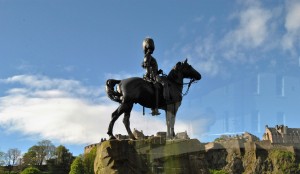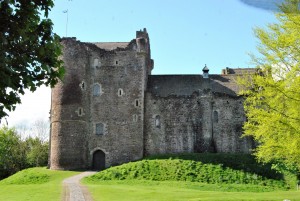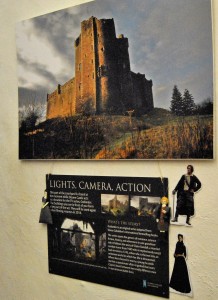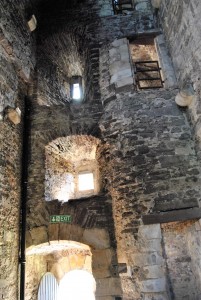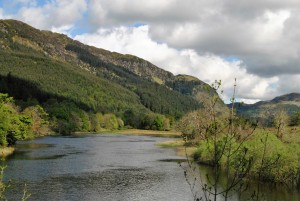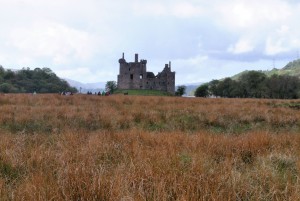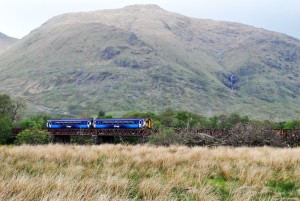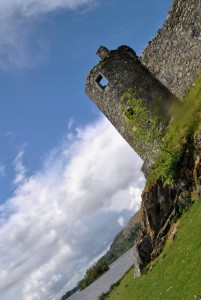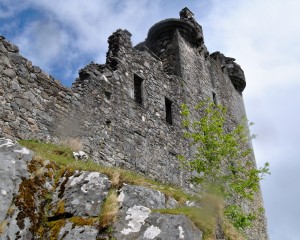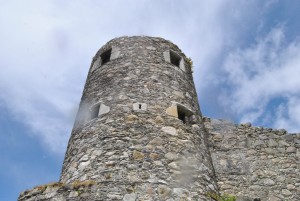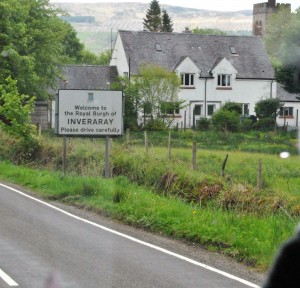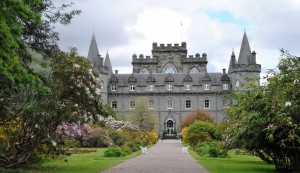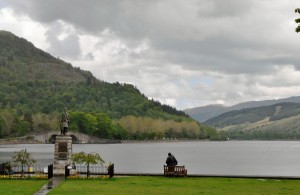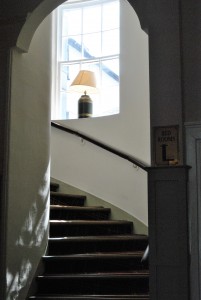My first full day in Cornwall–a bit chilly and gray this morning….I love this Inn While the Cornishman has its faults it’s lovely people and rambling building…not to mention great food make up for what the locals tell me is a change in management and personnel and the view of the church from the hall reminds me of my efforts to return to my book which I feel does need writing.
REMEMBERANCE OF 5/22/16
RABBIE’S WEST HIGHLAND LOCHS AND CASTLE DAY TOUR
We hopped a cab for Waterloo Place/Robbie’s lovely office and café in New Town….and new since we were here 4 years ago.
Departure at 8:30 am and heading west and north past Sterling to the Scottish Highlands.
First was a drive by (at a bit of a distance) Stirling Castle which is midway between Edinburgh and Glasgow. The castle figured prominently in the Scottish war of sucession in the Middle Ages and like Edinburgh passed bck and forth between the English and the Scots until the Scots took and held it in 1342. It was once known as “the Key to Scotland”,
Then on to Doune–which was built for Robert Stewart, where we had a short visit. The castle is quite the media location and has been featured in films including Monty Python and the Holy Grail and more recently in Outlander TV series based on Diana Galbaldon’s novels….which was renewed for two more years….HURRAY.
It remained a Stewart stronghold until it fell to ruins in the 18th century. It is now fully and beautifully restored and well worth a visit.
It was here that Albany’s son put to death James I in 1420.
We enjoyed the castle a lot and wander about and even bought a couple of things in the gift shop—nothing Outlander I’m trying to control my addiction.
The central court yard and great hall are very enlightening as to how these castles really functioned and the narrow passages show how they used the architecture in the violent times of the castle’s existence to ensure the inhabitant’s safety.
Then through Collander, the self proclaimed gateway to the Highlands with its pleasant houses built in Regency Style.
Rob Roy and Trossach’s Visitor’s center makes this a popular town to explore the park’s craggy hills and locks.
Then under the guidance of our lovely Lady Tour Guide & Driver we went on our thru Lock Lomond and Troach’s National park…the lake allows no powerboats or jet skis.
On to Kilchum Castle which is situated on the 27 mile long Lock Awe, which is Scotland’s longest in-land lake.
We walked through marshy landscape to reach this former Campbell stronghold that was abandoned after it was struck by lightening in the 18th century.
Built in the mid 1400s by Sir Colin Campbell–the first Laird of Glenorchy–the lonliness of the spot, the long stretches of almost marsh on one side and lake on the other and the stark stone ruins is both beautiful and yet forbidding.
This branch of the Campbell family (later the earls of Breadolbane) became very powerful and at one time almost rivaled the clan chiefs–the Earls of Argyle.
Susi decided to settle down and let me transverse the castle, which was the Campbell’s of Glenorchy’s power base for 15 years–on my own.
The 2nd Laird (Duncan) added the lower hall before he died at Flodden in 1556. The 3rd (1523) and 4th (1556) also died in battle. Collin the 6th laird added the turrents but later relocated to Baloch before 1583.
By the 1600’s the castle was an outpost for the government troops and was in use for the Jacobite uprising in 1715 and 1745.
Then it was back through Campbell Country to the town of Inveraray
The white washed town is the traditional town of the Campbell Clan Chiefs. It was relocated when the laird decided to built his new castle 1/2 mile from its original location.
We dropped some of the group in the castle–built in 1743 by the Duke of Argyll. It contain a wealth of historical relics, including portraits, tapestries, paintings and even a few ghosts.
Allied troops trained here during WWII
after visiting some shops Susi and I opted for lunch
then walking out into town again
The Artic Penguin is a former lightship converted to look like a schooner. Built in 1910 by Dublin Drylock Co. Ltd of Dublin. It was used to house a maritime museum until recently
Ok power is going so I am too…I will finish the tour for you tomorrow and update you on Cornwall and more……



